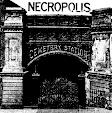ON THE SEVENTEENTH NIGHT OF HALLOWEEN … I watched a second feature about demonic forces and Satanic rituals: City of the Dead (1960), directed by John Llewellyn Moxey.
At the center of a Massachusetts village in 1692, a witch named Elizabeth Selwyn is burned at the stake (note that no actual accused witches were burned during the witch hysteria in the colonies—they were all hung). Cut to the present. A sinister professor of folklore who specializes in witchcraft (played by the one and only Christopher Lee) persuades an eager young grad student to travel to this same village for her dissertation research. She ignores the pleas of a local gas station attendant to steer clear of this village, which he says is cursed. After she arrives in the fog-shrouded community, she is booked into the inn by a woman who looks exactly like Elizabeth Selwyn. Soon, the student hears ritual chanting beneath her room’s floorboards. She finds a moldering tome called A Treatise on Devil Worship, which details the yearly sacrifices of young women such as herself made on Candlemas Eve and the Witches’ Sabbath. And she uncovers a network of catacombs beneath the village, which she unwisely ventures into alone.
Perhaps owing to the fact that City of the Dead was an entirely British production with an American setting and characters, it’s fairly hammy and sometimes cartoonish, with a lot of shaky accents. This makes it rough in the early scenes but actually works in its favor once we get to the village in the modern day. The fog machines and extremely crooked wooden props are put to great use in creating an archetypically spooky, cemetery-dominated little community of secret witches. Every development is telegraphed, and every characterization is obvious. But this is surely what has made it such a stock work of Satanic cinema, with its dialog having been sampled by Iron Maiden, The Misfits, and Rob Zombie. Meanwhile, of course, as he always does, Christopher Lee steals the show.
TWISTED TWINS & DUPLICITOUS DOPPELGÄNGERS:
City of the Dead’s doppelgänger is the head witch, in that her death in 1692 and her reappearance in the twentieth century makes her an identical reincarnation of herself. Her pact with Satan, wherein she offers annual blood sacrifices in exchange for immortality, has succeeded. The standard method by which the identical-ancestor trope is delivered is to have a character see a very old painting or photograph of the precursor and be shocked by the close resemblance to the modern iteration. Here, the viewer sees that the witch who is roasted in the seventeenth century and the current-day innkeeper are played by the same woman. But there is no reveal for the characters that the witch is her own doppelgänger across the centuries, which is a bit of a letdown.
Another sense in which this film contains doppelgängers is that the members of its underground witch cult masquerade as ordinary citizens. The theory that such a cult has survived in secret for millennia, despite centuries of Christian persecution, was adopted by early British folk horror films like this from the anthropologist Margaret Murray’s notorious book, The Witch-Cult in Western Europe. Though this book’s claims were largely discredited, the idea that adherents to an ancient pagan religion of ritual magic hide among us, wearing the faces of the most respectably conventional members of our society, has left a powerful impression on our collective imagination.

.png)
No comments:
Post a Comment